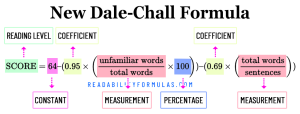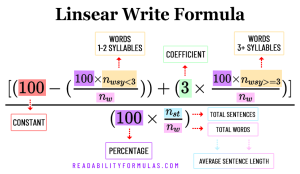Readability formulas help you measure how clear your writing is. These mathematical models analyze various linguistic features of text to assess its readability. They usually output a grade level needed to comprehend the text. They let you know (to some degree) if your readers will understand your text. Writers often use them for English texts, but for Spanish, you need to think about the language and culture.
Dr. Ana López-Sanz, a language and linguistics professor, explains: “Readability formulas tailored for Spanish can provide valuable insights into the linguistic features that impact comprehension. They allow writers to fine-tune their content to match the audience’s reading abilities.”
I.
Problems Scoring Spanish Text
If you tried scoring Spanish text (or translated Spanish text to English) through a readability formula, the final results might have perplexed you. The grade level, reading difficulty, and word stats probably looked all wrong—and most likely they were. That’s because most formulas were developed by English-language linguists analyzing only English texts, not other languages. Spanish, like other languages, has its own syntax and semantics that differ significantly from English.
For example:
1. Linguistic Differences: Spanish and English have distinct grammatical structures, syntax, and sentence patterns. For example, Spanish often uses longer sentences and passive voice more frequently than English.
2. Cultural Context and Idioms: Spanish includes many idiomatic expressions and cultural references. These expressions can influence the perceived complexity or simplicity of a text.
3. Regional Variations: Spanish is spoken in various countries across the world, each with its own dialects and linguistic nuances. A formula that works well for one variant of Spanish might be ineffective for another.
4. Syllable Structure/Word Length: Spanish words tend to have more syllables compared to English words. Formulas that score syllables or word length might overestimate the reading difficulty of Spanish texts.
5. Different Educational Standards: Readability formulas often correlate text complexity with educational grade levels. However, educational systems and standards vary across Spanish-speaking countries. A formula calibrated to one country’s school system may not be universal.
6. Lack of Tailored Formulas: A few readability formulas do exist for Spanish, such as the Fernández Huerta and Szigriszt-Pazos formulas; however, they are not widely recognized or used as their English counterparts.
7. Translation Issues: If you use a readability formula to score translated texts, the quality of the translation can skew the results. Literal translations might not capture the nuances of the original language.
8. Vocabulary: Spanish has many diverse words, including regional variations. Readability formulas consider familiar and complex words.
9. Grammar and Syntax: factors like verb conjugation and agreement determine how readable the text is.
10. Cultural nuances: Cultural aspects unique to Spanish-speaking regions, such as idioms, play a role in readability. Knowing these nuances ensures the content aligns with the target audience.
Dr. Miguel Hernández-Gómez, a readability researcher, suggests that, “Spanish readability formulas should incorporate metrics that capture sentence structure and syntactic variations, as they heavily impact the overall clarity of the text.“
11. Regional variations: Spanish is spoken across various countries and regions, each with its own linguistic and cultural characteristics. Readability formulas must (and currently do not) account for these regional variations to maintain clarity and relevance. For instance, a text using “coche” (car) in Spain but “carro” in Latin America might receive different complexity scores based on the regional terms used.
Dr. María José Rodríguez-Conde, a linguistics professor at the University of Barcelona, emphasizes: “A one-size-fits-all approach doesn’t work for Spanish readability. We must consider regional variations, vocabulary choices, and cultural references to ensure clarity and resonance.”
II.
Readability Formulas for Spanish Text
- The Fernández-Huerta Index: Juan Fernández Huerta modified the Flesch Reading Ease formula to score Spanish-language texts. It measures the average sentence length and syllable count to score text complexity.
- The Szigriszt-Pazos Formula: Developed by László Szigriszt and María Pazos, this formula evaluates Spanish text based on the number of syllables per word, the number of words per sentence, and the number of sentences per paragraph.
- Crawford Readability Formula: Originally developed for English, it has been adapted for Spanish. It uses the average number of words per sentence and the percentage of difficult words to assess readability.
- Sol Readability Formula: This formula is designed for Spanish texts and is based on the number of syllables per 100 words and the number of words per sentence.
- Análisis de la Comprensibilidad del Texto (ACT): This formula evaluates the readability of a text based on syntax and semantic factors, such as sentence complexity and vocabulary difficulty.
- Índice de Perspicuidad de Spaulding: Adapted for Spanish, this formula takes into account the average number of syllables per word and the average number of words per sentence.
- Legibilidad de Muñoz y González: This method assesses the readability of Spanish texts by analyzing the average sentence length and the complexity of vocabulary.
- Índice de Legibilidad de Szigriszt-Pazos (ILSP): An adaptation of the Flesch formula, it measures text difficulty based on syllable count and sentence length, specifically tailored for the Spanish language.
- Formula de Barrio: Developed for Spanish, this formula assesses readability based on word and sentence length, as well as the complexity of the text structure.
- Gutiérrez de Polini Formula: This formula was developed to score the ease or difficulty of Spanish text. The final score correlates to a reading scale, ranging from very easy to very difficult.
The following readability formulas were developed using the English language, but can be adjusted to process Spanish texts.
Flesch-Kincaid Grade Level: This formula can be adapted for Spanish text by considering the structure, complexity, and average syllables per word in Spanish sentences.
-
Syllable Count: Spanish words tend to have more syllables on average compared to English. Therefore, you may need to adjust the threshold for what’s considered a “complex” word. For example, in English, words with three or more syllables are complex. In Spanish, you might set the threshold at four or more syllables.
-
Sentence Length: Consider the average sentence length in Spanish. You may need to use different values for sentence length when calculating the grade level.
-
Spanish Grammar: Pay attention to the grammar and structure of Spanish sentences. Spanish has a different sentence structure compared to English, so you may need to account for this.
Flesch Reading Ease: This formula provides a score between 0 and 100, indicating if readers will find the text easy or difficult to understand. Higher scores means greater readability. The formula considers sentence length, word length, and the frequency of commonly used words.
-
Word Length: In Spanish, word length can affect readability. Adjust the formula to consider the average word length in Spanish text.
-
Commonly Used Words: Consider the frequency of common Spanish words when calculating the readability score. This may involve creating a list of frequently used Spanish words for reference.
SMOG Index: The SMOG Index calculates the grade level required to understand a text based on the number of polysyllabic words.
-
Polysyllabic Words: Determine what is a polysyllabic word in Spanish. In English, words with three or more syllables are polysyllabic. You may need to adjust this threshold for Spanish text.
-
Spanish Vocabulary: Consider the vocabulary and common word forms in Spanish when identifying polysyllabic words.
Prof. Roberto Gómez-Carballo, a readability researcher, says: “Spanish readability formulas should consider the nuances of the Spanish language and the diversity of Spanish-speaking regions to ensure accurate readability assessments.”
Readability helps writers communicate with diverse audiences, bridge cultural and linguistic divides, and foster a world where clarity and understanding transcend language barriers.
Research Papers and Academic Journals:
- The Fernandez-Huerta Formula, a Spanish adaptation of the Flesch Reading Ease score, detailed in a paper available on the National Center for Biotechnology Information (NCBI) website. [ website ]
- A validation study for Spanish readability formulas for elementary-level texts found on Tandfonline. [ website ]
- Research on readability of Spanish-language Patient Education Materials (PEMs) regarding bariatric surgery from Semantic Scholar. [ website ]
- A study on reading comprehension in university texts, focusing on metrics of lexical and syntactic readability in Spanish, mentioned on Springer. [ website ]
Online Readability Tools:
- LanguageTool, an online grammar checker for Spanish, useful for identifying grammatical errors and improving readability. [ website ]
- Fry readability assessment tool validated in Spanish, which can produce predictable U.S. Grade Levels, as discussed by Language Solutions Inc. [ website ]
- TextGears, an online Spanish grammar checker that also includes readability checks. [ website ]
Educational Resources:
- Español abierto, offering open educational resources for the Spanish classroom, including videos and activities for Spanish language learners. [ website ]
- NEH-Edsitement, providing a range of Spanish language learning resources. [ website ]
- Colorín Colorado, featuring bilingual resources and activities in Spanish for young children. [ website ]
- PBS LearningMedia, offering resources for reading and writing in Spanish, including animated videos and interactive lessons. [ website ]
Scott, Brian. “Readability Formulas to Score Spanish Texts.” ReadabilityFormulas.com, 25 Jan. 2025, https://readabilityformulas.com/readability-formulas-to-score-spanish-texts/.








